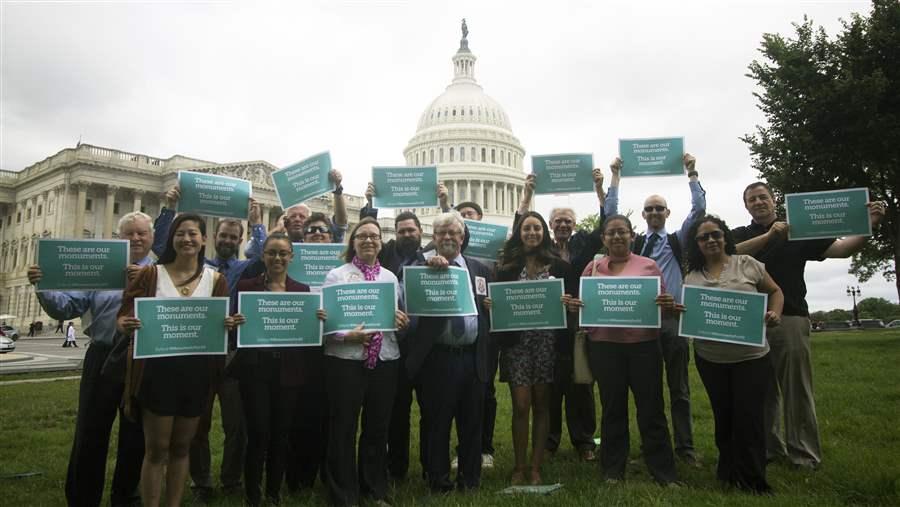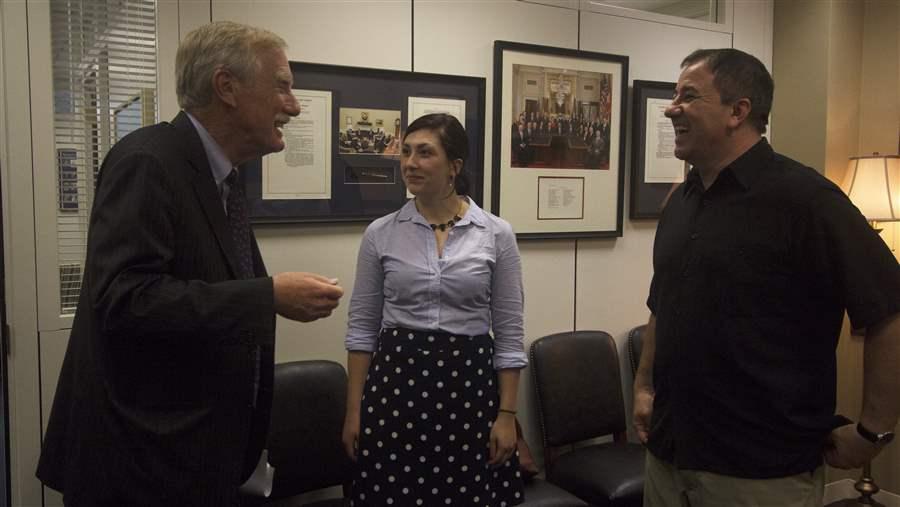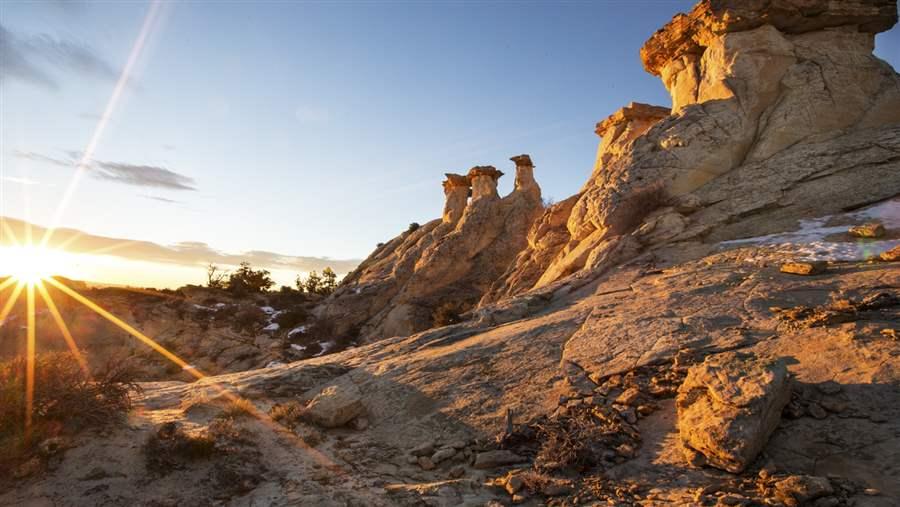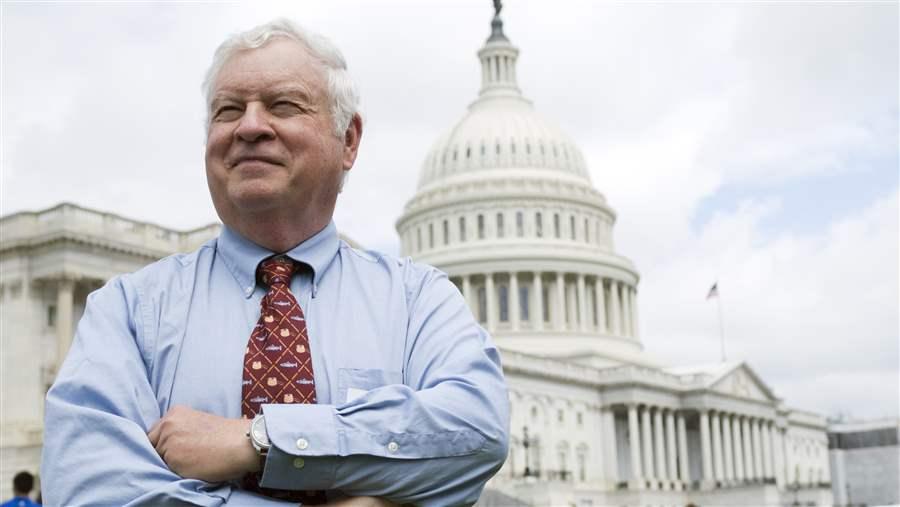National Monuments Boost Businesses and Communities
Locals visit Capitol Hill seeking to preserve the widespread benefits of public lands

Activists from across the country gathered in Washington to urge U.S. lawmakers to protect America’s national monuments.
© Fred Baldassaro/The Pew Charitable Trusts
Update: The period for public input on the Trump administration’s national monument review closed July 10 with more than 2 million comments submitted. Interior Secretary Zinke has until Aug. 24 to present his recommendations on the monuments to President Trump.
Advocates led by small-business owners seeking to preserve an economic juggernaut brought the fight to save America’s national monuments to the front lines June 7. Some three dozen people from 15 states traveled to Washington to tell their elected representatives that the country’s monuments do much more than provide space for those seeking outdoor recreation and solitude: They also lift local and regional economies by creating revenue streams from tourism.
Economic activity around northern Maine’s Katahdin Woods and Waters National Monument has improved, said John Hafford, who owns a design business in nearby Millinocket. “More people are coming to the area, there’s more investment, more optimism. And that’s been especially welcome in a place that was feeling starved of oxygen” after the slump in the regional paper industry, which began long before Katahdin was established last August.

Senator Angus King (I-ME), left, meets with John Hafford and Pew's Anna Pacilio. Hafford owns a business near Katahdin Woods and Waters National Monument and was advocating for its protection.
© Fred Baldassaro/The Pew Charitable Trusts
Despite the new wave of activity, Katahdin is under threat: It is among 27 national monuments that Interior Secretary Ryan Zinke is reviewing for possible reduction or elimination. Hafford was among those who visited their senators and representatives to urge them in person to maintain the monuments as they are.
Hafford’s experience in Maine is common, according to a new study that found that local economies around national monuments expand after their creation. The research, by Headwaters Economics, a Montana-based nonpartisan research firm, documented the growth in every one of 17 monuments it studied in 11 western states. Broadly, counties surrounding national monuments recorded growth in per capita income, jobs, population, and real personal income. And in 13 of the 17 areas, the growth outpaced what was occurring in comparable counties, showing that the effect was not simply due to a regionwide boom.
Others who came to visit lawmakers had a similar message.
“The economic argument for public lands has become so much more important,” said Carrie Hamblen, CEO and president of the Las Cruces (New Mexico) Green Chamber of Commerce. She said establishment of the Organ Mountains-Desert Peaks National Monument in her state has driven a sustained surge of business.
“We’ve got numerous outfitters and support businesses, all due to the monument,” Hamblen said, noting that the uplift had been forecast in an economic impact study.
Keith Watts, a geologist who guides backcountry trips into Grand Staircase-Escalante National Monument in southern Utah, said that before the monument’s creation in 1996, the adjacent city of Escalante “had tumbleweeds blowing down the streets—it was basically dead. Now there’s a business in every available building, all of it driven by the monument. The talk around town used to be about ‘no jobs.’ Now it’s about ‘not enough employees to fill all the jobs.’”

Hoodoo rock formations in Grand Staircase-Escalante National Monument in Utah.
© Bob Wick/Bureau of Land Management
Watts hastened to sing some of the better-known praises of his home monument. “Southern Utah has the most phenomenal landscape I’ve seen anywhere in the world,” he said, citing the slot canyons, pastel-banded cliffs, turquoise streams, and improbable rock formations. “I take clients into Grand Staircase, and we won’t see another person all day—and that’s not something you can easily find anymore. Once these places are lost, you don’t get them back.”
Preserving the monuments as they are—and ideally creating more—also has strong backing from American sportsmen, according to Jack Williams, senior scientist and science team lead at Trout Unlimited in Medford, Oregon.

Scientist Jack Williams was in Washington to urge lawmakers to preserve the Cascade-Siskiyou National Monument as it is.
© Fred Baldassaro/The Pew Charitable Trusts
“Our members are big on public lands,” Williams said. “They understand the value of backcountry fishing and hunting, and want as many of those opportunities as they can get.” One such opportunity exists in Jenny Creek in the Cascade-Siskiyou National Monument, which covers approximately 97,000 acres in southern Oregon and 5,000 acres in northern California. The creek is home to the diminutive—and rare—redband trout.
By protecting a broad area, Williams said, the monument “secures the snowpack”—that is, helps safeguard it from pollution and melting more quickly than it should under normal conditions —and that helps maintain high water quality in the rivers and streams below.
Stuart Warren guides fly-fishing trips on Oregon’s Rouge River and joined Williams on the Capitol Hill visits. “My business is entirely dependent on water quality,” Warren said. “If the streams get muddied up, people don’t want to fish.” Both men countered critics who say Cascade-Siskiyou contributed to the decline of Oregon’s timber industry, noting that logging jobs began dropping two decades before the monument was created.
Echoing the sentiments of many business owners and residents who live near national monuments, Warren explained, “Tourism is the main economic driver now. It is definitely the future of our region.”
The Pew Charitable Trusts helped organize the congressional visits, along with The Wilderness Society, Conservation Lands Foundation, and Next 100 Coalition. The public has until July 10 to submit formal comments on Secretary Zinke’s review of the national monuments. To share your opinion, click here.
Mike Matz directs The Pew Charitable Trusts’ U.S. public lands program.


Oregon Monument's Rich Biodiversity Merits Continued Protection
Administration order threatens Cascade-Siskiyou and the array of outdoor recreation it offers


Utah Monument an Economic Boon
Utah national monument, renowned for hiking and fossils, boosts jobs and income nearby


Maine’s National Monument Shows Value
Evidence shows value of Katahdin as President Trump starts review of public lands and waters







